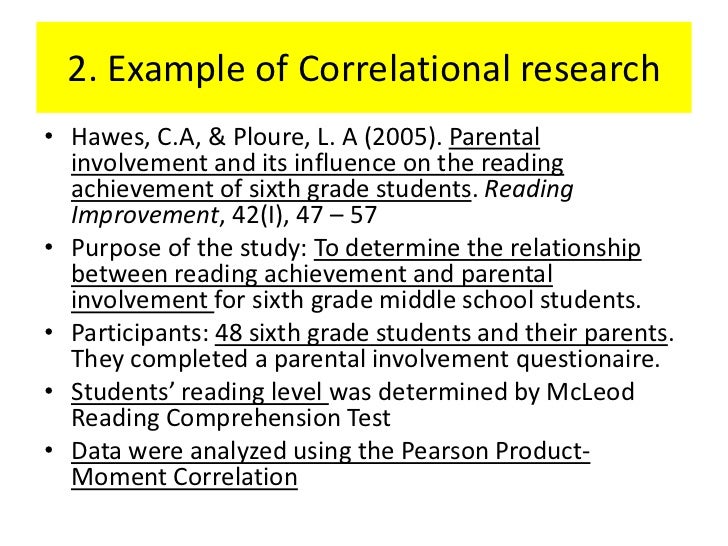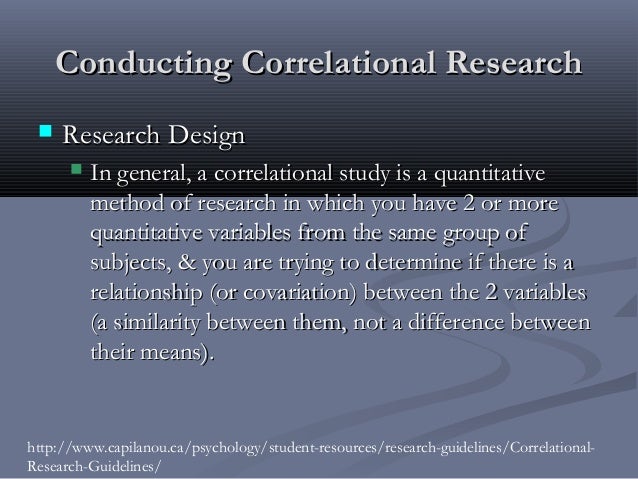Table Of Content

Different types of correlation coefficients and regression analyses are appropriate for your data based on their levels of measurement and distributions. Using secondary data is inexpensive and fast, because data collection is complete. However, the data may be unreliable, incomplete, or not entirely relevant, and you have no control over the reliability or validity of the data collection procedures.
Qualitative Research Methods
Another strength of correlational research is that it is often higher in external validity than experimental research. Recall there is typically a trade-off between internal validity and external validity. As greater controls are added to experiments, internal validity is increased but often at the expense of external validity as artificial conditions are introduced that do not exist in reality.
3.4. Adherence to Good Practices in Prospective Observational Studies
Precise specification of the sampling process in this way makes data collection manageable for the observers, and it also provides some control over important extraneous variables. For example, by making their observations on clear summer days in all countries, Levine and Norenzayan controlled for effects of the weather on people’s walking speeds. There are growing populations with multiple chronic conditions and healthcare interventions.
Exercise
The aim of longitudinal research is to provide insights into the development, growth, or decline of a particular phenomenon over time. Case study research design is used to investigate a single case or a small number of cases in depth. It involves collecting data through various methods, such as interviews, observations, and document analysis. The aim of case study research is to provide an in-depth understanding of a particular case or situation. In the naturalistic observation method, you need to collect the participants’ data by observing them in their natural surroundings.
Archival data is useful for investigating the relationships between variables that cannot be manipulated or controlled. Correlational Research is a type of research that examines the statistical relationship between two or more variables without manipulating them. It is a non-experimental research design that seeks to establish the degree of association or correlation between two or more variables. If two variables are correlated, it could be because one of them is a cause and the other is an effect. But the correlational research design doesn’t allow you to infer which is which.
Gain insights with 80+ features for free
(PDF) Artificial Intelligence Adoption and Marketing Performance of Quoted Manufacturing Firms in Nigeria - ResearchGate
(PDF) Artificial Intelligence Adoption and Marketing Performance of Quoted Manufacturing Firms in Nigeria.
Posted: Thu, 31 Aug 2023 07:00:00 GMT [source]
Researchers need to be aware of the specific factors related to the people taking the survey that will affect its outcome. For example, study subjects might act differently if they know that they are being watched. The researchers might not be aware that the behavior that they are observing is not necessarily the subject's natural state (i.e., how they would act if they did not know they were being watched).

Add to Collections
Researchers use correlations to see if a relationship between two or more variables exists, but the variables themselves are not under the control of the researchers. Path analysis is a statistical method used to model the relationship between multiple variables. Researchers use path analysis to test causal models and identify direct and indirect effects between variables.
A confounding variable is a third variable that influences other variables to make them seem causally related even though they are not. Instead, there are separate causal links between the confounder and each variable. You have developed a new instrument for measuring your variable, and you need to test its reliability or validity. However, you can carry out correlational research to find out if victims of domestic violence suffer brain hemorrhage more than non-victims. Naturalistic observation has revealed that bowlers tend to smile when they turn away from the pins and toward their companions, suggesting that smiling is not purely an expression of happiness but also a form of social communication. By Kendra Cherry, MSEdKendra Cherry, MS, is a psychosocial rehabilitation specialist, psychology educator, and author of the "Everything Psychology Book."
What are the Differences between Correlational and Experimental Research?
Correlational research is a type of research method that involves observing two variables in order to establish a statistically corresponding relationship between them. The aim of correlational research is to identify variables that have some sort of relationship do the extent that a change in one creates some change in the other. This is an example of content analysis—a family of systematic approaches to measurement using complex archival data. Just as naturalistic observation requires specifying the behaviors of interest and then noting them as they occur, content analysis requires specifying keywords, phrases, or ideas and then finding all occurrences of them in the data. They simply measured out a 60-foot distance along a city sidewalk and then used a stopwatch to time participants as they walked over that distance. For example, researchers Robert Kraut and Robert Johnston wanted to study bowlers’ reactions to their shots, both when they were facing the pins and then when they turned toward their companions (Kraut & Johnston, 1979).
Correlational research observes and measures historical patterns between 2 variables such as the relationship between high-income earners and tax payment. Correlational research may reveal a positive relationship between the aforementioned variables but this may change at any point in the future. Negative correlational research is a research method involving 2 variables that are statistically opposite where an increase in one of the variables creates an alternate effect or decrease in the other variable. An example of a negative correlation is if the rise in goods and services causes a decrease in demand and vice versa. This type of research is descriptive, unlike experimental research that relies entirely on scientific methodology and hypothesis.

It helps find the association between variables based on the participants’ responses selected for the study. In correlational research design, a researcher measures the association between two or more variables or sets of scores. A correlation coefficient is an important value in correlational research that indicates whether the inter-relationship between 2 variables is positive, negative or non-existent. It is usually represented with the sign [r] and is part of a range of possible correlation coefficients from -1.0 to +1.0. Correlational research examples are numerous and highlight several instances where a correlational study may be carried out in order to determine the statistical behavioral trend with regards to the variables under consideration. The survey method is the most common method of correlational research; especially in fields like psychology.
Pearson’s r is a good measure only for linear relationships, in which the points are best approximated by a straight line. It is not a good measure for nonlinear relationships, in which the points are better approximated by a curved line. Figure 6.5, for example, shows a hypothetical relationship between the amount of sleep people get per night and their level of depression. In this example, the line that best approximates the points is a curve—a kind of upside-down “U”—because people who get about eight hours of sleep tend to be the least depressed. Those who get too little sleep and those who get too much sleep tend to be more depressed. Even though Figure 6.5 shows a fairly strong relationship between depression and sleep, Pearson’s r would be close to zero because the points in the scatterplot are not well fit by a single straight line.
However, this does not mean that researchers will get reliable data from watching the variables, or that the information they gather will be free from bias. In some cases, it might be the only method available to researchers; for example, if lab experimentation would be precluded by access, resources, or ethics. It might be preferable to not being able to conduct research at all, but the method can be costly and usually takes a lot of time. A correlation is usually tested for two variables at a time, but you can test correlations between three or more variables. A correlation reflects the strength and/or direction of the association between two or more variables.
The observers committed this list to memory and then practiced by coding the reactions of bowlers who had been videotaped. During the actual study, the observers spoke into an audio recorder, describing the reactions they observed. Among the most interesting results of this study was that bowlers rarely smiled while they still faced the pins. They were much more likely to smile after they turned toward their companions, suggesting that smiling is not purely an expression of happiness but also a form of social communication.

No comments:
Post a Comment